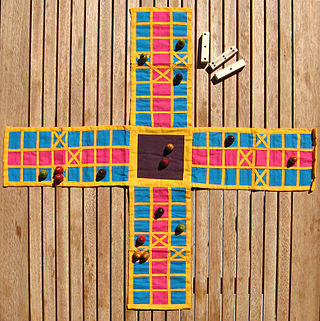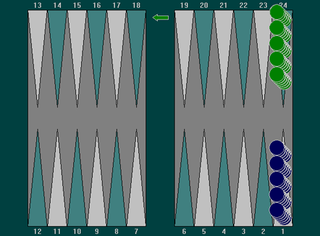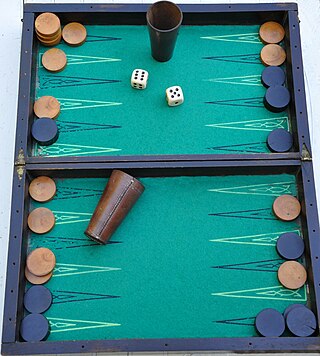
Chase is a board game published by TSR in 1985.

Chase is a board game published by TSR in 1985.
Chase is a two-player abstract boardgame. [1] The components are:
Each player places 9 of their dice on the end of the board closest to them, and turn the dice so that the values on the top of the dice add up to 25. Each player must always have a total value of 25 on the board at all times. The tenth die is held as a spare. Players then take turns either moving their dice to capture the other player's dice, or exchanging dice values. [2]
The active player can choose to move a die in any direction in a straight line for a number of hexes equal to the number of pips showing on the die. The die cannot move through a space occupied by any other die of either side, and cannot move through the center hex. If a die reaches the side of the board and still has movement left, it "wraps" around the board (reappears in the analogous hex on the opposite side of the board). If a die "hits" the end of the board and still has movement left, it caroms off the end at a corresponding angle. [2]
If a die ends its turn on a space occupied by a die of the same color, the incoming die will "bump" the occupying die one space in the same direction. If the second die moves into a space occupied by a third die of the same color, the third die is also bumped. [2]
If a die ends its turn in the center hex (called the "chamber space"), it is split in two: the player brings on a reserve die and both dice receive half the amount of pips the incoming die had (unless the incoming die had an odd number, in which case the incoming die will retain the extra pip.) [2]
When a die ends its turn on a hex occupied by their opponent's die, the incoming die captures the defending die. The defender removes the captured die from the board, and adds the number of pips on that die to another die still on the board (thus keeping the total value of pips on that team at 25). For example, the red player moves a red die onto a hex occupied by a blue die with the value of 3. The blue player removes the die from the board, and increases any blue die on the board by 3 to maintain the total point value of 25. [2]
If a player bumps one of their dice and the bumped die lands on an opponent's die, then the bumped die successfully captures the opponent's die. [2]
If two die of the same colour are adjacent to each other, the player can choose to have the two dice exchange values instead of moving those dice. The player moves value from one of the dice to the other such that the total value of the two dice remains the same. For example, two adjacent dice with values of 4 and 2 could have their values changed to 5-1, 3-3, 2-4 or 1-5. [2]
Mike Brunton reviewed Chase for White Dwarf #93, and stated that "Chase was deservedly in Omni's Top Ten games when it was released, no bad recommendation in itself. It also gets a highly recommended here." [1]
On the games review website Geeky Hobbies, Eric Mortensen noted "Despite the game being pretty simple, there is quite a bit more strategy to the game than you would expect." Mortensen didn't like the large number of choices to make on each turn, stating "I love games that give you options but there is a point when it becomes too much. Each dice has a possibility of six different movements on every turn." He pointed out that "this can lead to some serious analysis paralysis where you are stuck waiting around for the other player to make their move. [...] If you play with two players that always have to maximize their moves the game can become boring pretty quickly." He concluded with a recommendation to not purchase the game, saying, "I just didn’t find Chase to be that fun to play. [...] The game just feels like an exercise of moving pieces around the board while occasionally capturing some pieces." [2]

Backgammon is a two-player board game played with counters and dice on tables boards. It is the most widespread Western member of the large family of tables games, whose ancestors date back nearly 5,000 years to the regions of Mesopotamia and Persia. The earliest record of backgammon itself dates to 17th-century England, being descended from the 16th-century game of Irish.

Ludo is a strategy board game for two to four players, in which the players race their four tokens from start to finish according to the rolls of a single die. Like other cross and circle games, Ludo is derived from the Indian game Pachisi. The game and its variations are popular in many countries and under various names.

Pachisi is a cross and circle board game that originated in Ancient India. It is described in the ancient text Mahabharata under the name of "Pasha". It is played on a board shaped like a symmetrical cross. A player's pieces move around the board based upon a throw of six or seven cowrie shells, with the number of shells resting with the aperture upward indicating the number of spaces to move.

Trouble is a board game in which players compete to be the first to send four pieces all the way around a board. Pieces are moved according to the roll of a die using a contained device called a "Pop-O-Matic". Trouble was developed by the Kohner Brothers and initially manufactured by Irwin Toy Ltd., later by Milton Bradley. The game was launched in America in 1965. The classic version is now marketed by Winning Moves Games USA. The gameplay, board, and concept is derivative of the British board game Ludo, itself based on the Indian board game pachisi.

Parqués is the Colombian version of a board game in the cross and circle family. The game is described as a "random thinking" game: the moves depend on the roll of the dice but players must consider possible strategies before executing their move. The objective of the game is to advance all the pieces to the end. Once in the safety zone player can use 2 dice until they are one space away from home, where they will then just use one die.

Parcheesi is a brand-name American adaptation of the Indian cross and circle board game Pachisi, published by Selchow & Righter and Winning Moves Games USA.

Sorry! is a board game that is based on the ancient Indian cross and circle game Pachisi. Players move their three or four pieces around the board, attempting to get all of their pieces "home" before any other player. Originally manufactured by W.H. Storey & Co in England and now by Hasbro, Sorry! is marketed for two to four players, ages 6 and up. The game title comes from the many ways in which a player can negate the progress of another, while issuing an apologetic "Sorry!"

Nard is an historical Persian tables game for two players that is sometimes considered ancestral to backgammon. It is still played today, albeit in a different form. As in other tables games, the playing pieces are moved around a board according to rolls of dice. It uses a standard tables board, but has a different opening layout and rules of play from that of backgammon.

Chaturaji is a four-player chess-like game. It was first described in detail c. 1030 by Al-Biruni in his book India. Originally, this was a game of chance: the pieces to be moved were decided by rolling two dice. A diceless variant of the game was still played in India at the close of the 19th century.

Plakoto (Πλακωτό) is a tables game for two players that is popular in Greece. The object is for the player to bring all 15 pieces around to his or her own home board and then bear them off. The player who bears off all 15 pieces first wins the game. This game is usually played along with two other variants, Févga and Pórtes. Together these three games are called Távli, and are played in sequence usually one after the other. Game is three, five or seven points. A Middle Eastern version of this game is Mahbusa, and the Bulgarian version of Plakoto is known as Tapa and also as Tsillitón (Τσιλλιτόν), in Cyprus. Parlett places Plakoto in the same group as the popular mediaeval game of English, as well as the French games of Tieste and Impérial, the Italian game of Testa and Spanish Emperador.
Duell, also published under other names, is a two-player board game played with dice on a board of 9×8 squares. Players take turns moving one of their dice in order to capture their opponent's pieces, with the ultimate aim of capturing the opponent's key piece to win the game. It is considered a chess variant.

Jacquet is a tables game played on a backgammon-like board and which was once very popular in France and several other parts of Europe. It probably emerged around 1800, but is attested by 1827. In the 20th century it replaced the classic French backgammon equivalent — the game of Trictrac — until Jacquet itself was superseded by Anglo-American games in the 1960s.
A number of related games under the Yahtzee brand have been produced. They all commonly use dice as the primary tool for game play, but all differ generally. As Yahtzee itself has been sold since 1954, the variants released over the years are more recent in comparison, with the oldest one, Triple Yahtzee, developed in 1972, eighteen years after the introduction of the parent game.

Headache is a board game for in which the object is to land a playing piece on top of all opponents' pieces. Play moves in circles until one player has captured every other players' cones on the board and declared the winner. All players are welcome to occupy any space throughout the game, provided the die rolls allow, and there are eight spaces that serve as "safe" spots, where a cone resting on this space cannot be captured. Captured pieces are not sent back to start, but are permanently lost.
Catan: Traders & Barbarians is the third expansion to the Settlers of Catan games, developed by Klaus Teuber. It contains a series of new scenarios and small variations, which are meant for two, three, or four players, with limited compatibility between the other two expansions, Catan: Seafarers and Catan: Cities & Knights. Three of the modules had been previously offered as "mini-expansions", though two have new rules in Traders. The expansion itself is named for one of the scenarios therein.
Mojo is a two-player, 3 in-a-row abstract strategy board game played with original and unique "thrice-sliced-dice". The pieces, handmade to order in India, are colored with non-toxic vegetable dye. The individual opposite ends of the pieces are marked with pips and numbered similar to regular dice - i.e. they total 7. It takes all 3 pieces of a color to make up a single die.
This glossary of board games explains commonly used terms in board games, in alphabetical order. For a list of board games, see List of board games; for terms specific to chess, see Glossary of chess; for terms specific to chess problems, see Glossary of chess problems.

Trictrac is a French board game of skill and chance for two players that is played with dice on a game board similar, but not identical, to that of backgammon. It was "the classic tables game" of France in the way that backgammon is in the English-speaking world.

The following is a glossary of terms used in tables games, essentially games played on a Backgammon-type board. Terms in this glossary should not be game-specific, but applicable to a range of tables games.

Long Nardy, also just Nardy, is a Russian tables game for two players. It is also played in Armenia as Long Nardi or Nardi. It probably originated in the historical Persian game of Nard. It requires a tables board, 15 men apiece and two dice.